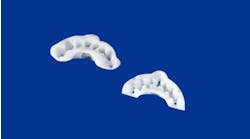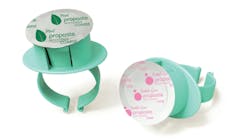by Anne Nugent Guignon, RDH, MPH
When I was in school at the University of Missouri–Kansas City 40 years ago, a few older dental professors used flip–up jeweler"s loupes. We thought they were strange at the time. Twenty years later, I went to work for a doctor who wore custom–made magnification loupes. A few years later, I met a dental hygienist at the American Academy of Periodontology Meeting in San Francisco, who also wore loupes. These two clinicians made a convincing argument regarding the benefits of magnification. Within a couple of months of the AAP meeting, I ordered my first pair of loupes and an ergonomic chair with arms, purchases that changed the course of my career. A year later, I purchased an auxiliary headlight, another career–altering event.
At some time in our careers, most of us have used a variation of the following dialogue: "Based on what I see, this is what I would recommend for my family member." Be honest, do you really mean it when you make a statement like that? I'm not so sure.
Just for fun, think about how you like to be treated as a dental patient. Would you willingly subject yourself, or those you love, to diagnostic or treatment modalities commonly employed 40 years ago? Of course not! Time and technology have moved every profession to a new level, and dental hygiene is not immune to change.
Based on informal polls conducted during my continuing education courses, well over 90 percent of all hygienists practice with doctors who wear loupes. Ten years ago, only a handful of hygienists wore magnification, but the numbers are increasing steadily and now the percentage of attendees using loupes range from 15 to 50 percent.
Many factors have fueled the increase in the number of hygienists wearing loupes. Today, the median age of North American dental hygienists is in the mid–forties, the average length of practice is around 16 years and more than half of all clinicians practice 32 hours a week or more (considered full–time employment). In addition, many dental hygienists are single parents or major breadwinners in their family unit. Many will remain practicing for many years to come.
Clinicians who have spent years working in less than ideal ergonomic environments find that magnification loupes play a significant role in improving posture, resulting in reduction of never–ending upper body aches and pains.
Some think that magnification is not appropriate until they reach a point where reading glasses are in order. In all actuality, postural improvements can never begin too soon. Early adoption of magnification is critical especially when one considers that several studies show that between 70 and 80 percent of all hygienists are practicing with some type of musculoskeletal pain or discomfort.
Although clinicians have led the trend, more educators are now embracing the value of wearing loupes. Recent studies in both Canada and the United States demonstrate magnification improves posture among dental hygiene students. Some academic institutions even require students to wear loupes during clinical training. Imagine having great visual acuity and good posture during one of the most stressful periods in your life — school!
For clinicians who don't wear loupes, the well–worn popular phrase "you don't know what you don't know" rings true. If you think that you are really seeing everything in the oral cavity without magnification, you're not. Just ask a friend who wears loupes. We're not being condescending; we just understand what you are not seeing.
Another common misconception is that magnification will make your eyes weak. Actually, the reverse is true. Often, first–time users purchase loupes just about the time their eyesight is changing because of the natural aging process. They attribute vision changes to working with magnification, without realizing that the events are not related, even though they occur at the same time.
Many companies have improved the quality of their optics over the past few years. Optical quality can vary dramatically. Resolution, which is the ability to see small structures clearly, is the most important factor to consider. In optics, the higher the resolution, the crisper the image, and quality optics feature an image that remains true across the entire surface of the ocular. Width of field is also an important consideration when choosing magnification. Additional considerations are the strength of the magnification, depth of field, and overall comfort.
Initially, some clinicians believe that the strength of the magnification is the most important factor, but a bigger image does not mean a better image. Recent advances in large screen TVs are a perfect example of how higher resolution, not a larger screen surface, creates better images.
Titanium and modern–day carbon composite are used to create loupes frames that are both durable and lightweight and available in many attractive colors and styles. Magnification systems come in fixed through–the–lens systems as well as flip–up styles. One company's new hybrid version features a TTL system mounted into a flip–up carrier lens, providing clinicians with the best of both worlds. Special prescription inserts are available that contain one's personal vision correction, eliminating the need to send the loupes to the factory when there is a vision change.
Adequate lighting is critical for optimal visual acuity. It's hard to read a book in a poorly lit room. The same applies for working in the mouth. Adding auxiliary illumination, attached directly to the loupes, takes magnification to an entirely different level, allowing one to experience all that magnification has to offer. Gone are the days of trying to perform intricate procedures in a cave–like atmosphere.
Lighting systems are available in both portable battery–operated and counter–mounted corded units. Halogen and metal halide lighting systems using a plug–in light source are typically brighter and crisper than battery–operated LED lights, but advances in lighting technology are rapidly closing the gap. The actual color of light varies per system, so make sure the color and intensity meet your personal clinical requirements. Halogen and halide systems use special replaceable bulbs. Always have a spare bulb handy. Illumination from an LED system comes from a blend of semi–conductors, eliminating the need for traditional bulbs.
Magnification and auxiliary illumination now allow us to practice using today's standard of care, not what was the norm when most of us graduated from our academic institutions.
There is nothing like being able to see subtle soft tissue changes, defective margins around restorations, or even the marks on a periodontal probe. The end results are more accurate diagnoses, more thorough treatment, and a body that will thank you daily for the reduction in stress. Research the options, make wise choices, and purchase the best products you can possibly afford. Once you experience enhanced visual acuity, there is no going back to what one friend calls the dark side. You will be in the comfort zone.
About the Author
Anne Nugent Guignon, RDH, MPH, is the senior consulting editor for RDH magazine. She is an international speaker who has published numerous articles and authored several textbook chapters. Her popular programs include ergonomics, patient comfort, burnout, and advanced diagnostics and therapeutics. Recipient of the 2004 Mentor of the Year Award, Anne is an ADHA member and has practiced clinical dental hygiene in Houston since 1971. You can reach her at [email protected] or (832) 971–4540, and her Web site is www.anneguignon.com.





